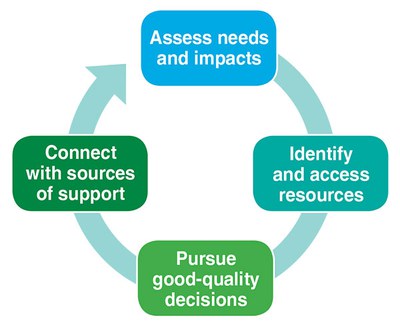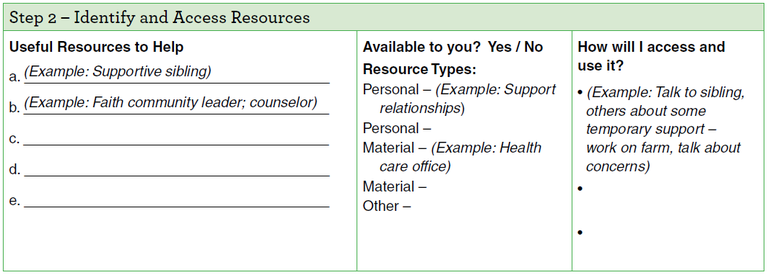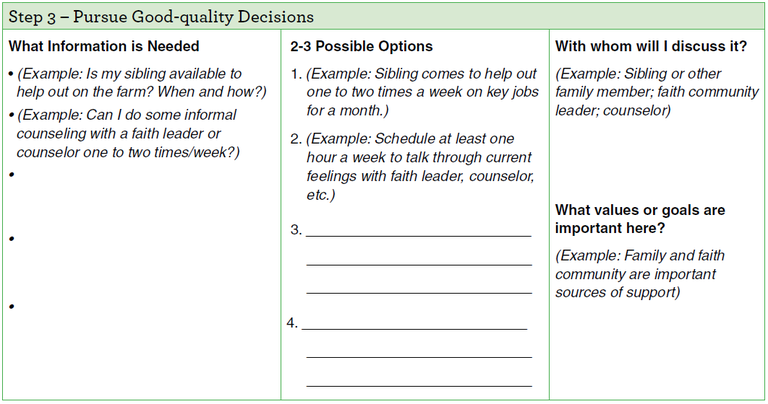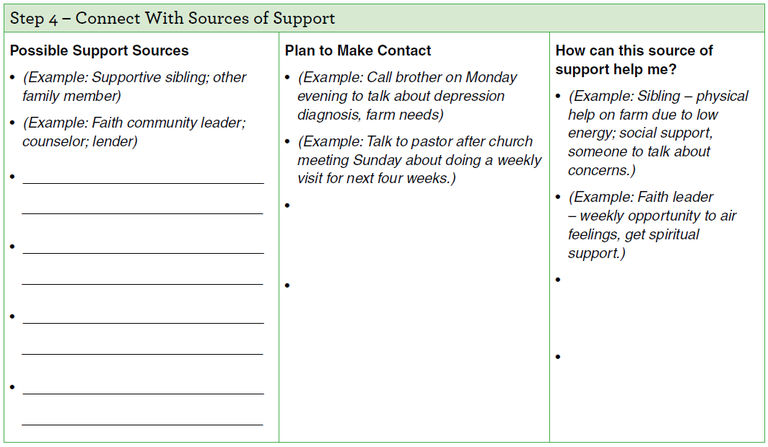4 Steps to Managing Stress in Farming and Ranching (FS1926, Aug. 2019)

Working in agriculture brings its own set of unique experiences and stresses. These stresses can range from equipment breakdowns to long hours to isolation from others. Signs of stress are warning signals, like the flashing yellow or red light on the dashboard of a car, that are reminding you to pay attention, slow down and take steps to check for signs of trouble.
Having a process that you can use in managing the pressures that impact your family, your farming operation and your life in general is helpful. This publication introduces four steps for managing stresses in the Managing Rural Stress Model. Although we face common stress experiences, the stresses for each individual or farming operation are unique. This model provides you with a process and set of steps for thinking about the different stressors you may experience and strategies for managing them more effectively.
The Managing Rural Stress Model allows you to use a reflective approach and explore multiple steps in dealing with stress concerns. It helps you identify and use effective resources and strategies. The four steps explored here are: (1) assess needs and impacts, (2) identify and access resources, (3) pursue good-quality decisions, and (4) connect with sources of support..
4 Steps to Managing Stresses in Farming and Ranching – A Model

What is Causing You Stress?
In farming and ranching, a source of stress might be short-term and simple to handle (such as mending a fence where livestock broke through) or it might be more long-term and challenging to handle (such as an injury that limits your ability to work for a couple of months). Stresses are common. You are not likely to get rid of all stresses. Instead, research suggests that how we think about and how we respond to stresses are most important in handling them in our lives.
In exploring the steps in the Managing Rural Stress Model, we will use a continuing example (in italics) to share ideas about how to use each step. We also encourage you to pick your own example and use the steps as a process to think about and respond to stresses identified in your own life or farming operation. See italicized text for examples.
Key Stressor (Example: Doctor diagnosed you with mild to moderate depression in the last month)
- Stressor 1 __________________________________________________________________
- Stressor 2 __________________________________________________________________
Once you have identified a particular source of stress, you can engage the steps in thinking about its impact and how to manage it in your life or farm/ranch operation.
Step 1 – Assess Needs and Impacts
Each source of stress typically creates a need in your life that is important to minimizing or managing the stress. For example, due to long hours or interruptions to your sleep schedule, a need may be “more and restful sleep.” Use the following points to explore this step:
- Identify the key needs resulting from the identified stressor in your life, family or farming operation. For the depression example, see two suggestions below. What are your needs?
- Next, assess the size of the impact occurring in your life or operation due to a stressor (small, medium, large).
Is it like dropping a pebble in your pond or throwing in a large rock? - Finally, think of the impact on a scale from “easy to manage” to “difficult to manage.” Where does it fit on the scale? Rate the impact from “easy to manage” to “difficult to manage.” (scale of 1 = easy to 7 = difficult)

Step 2 – Identify and Access Resources
To reduce or manage stress, a second step is to identify and access available resources that can assist you. Resources are what you have or can access to meet needs or goals. If you are thirsty, for example, the resource most helpful in meeting or reducing that need would be water (or juice, milk, etc.). Use the following points to explore this step:
- Identify the resources that will be of most help to you in managing a specific need or stress. Sometimes multiple resources can work together and be helpful. For example, if the need is getting more good-quality sleep, resources might include a new pillow, a better sleep schedule, journaling, a warm shower, physical exercise, avoiding TV or other screens before bed, or a neck massage to help you relax and feel ready to rest. Brainstorm about the resources that might help you!
- Assess availability of key resources and what might be done to access them. Also, what other resource types might help with a need. Resource types include:
- Personal resources – Knowledge; creativity; optimism; cooperation with others, support from others; trust; etc.
- Material resources – Money; land; labor; capital; equipment; professional help; community organizations; etc.
- Briefly describe a strategy to access and use key resources identified.

Step 3 – Pursue Good-quality Decisions
In the process of managing stresses, another step involves assessing the options and then making choices about how to respond. This step involves pursuing good-quality decisions and cultivating a mindset open to change. Perhaps you need to add a commodity crop to your farming operation but have not used it before. Maybe you need to visit with a counselor but you feel uncertain about sharing your stresses with someone. Use the following points to explore this step:
- Explore critical decisions you face about using resources to resolve concerns or reduce stresses, such as: Should we invest in new equipment or crop and livestock production strategies? Am I willing to visit with a professional about health concerns?
- Write down information that you need to feel informed and to enable you to make a good decision. Be open to new ideas and information.
- Assess the options that are available to you. What are the pros and cons, or benefits and costs, associated with each particular option? Explore how you feel about each option.
- List others with whom you trust to discuss a decision (family members, professionals, etc.).
- Clarify any values you hold or goals that are relevant to guiding you in making a decision.
- Be open to the possibility of change because you may need to make decisions that are different from past experience or go against old habits you have developed.

Step 4 – Connect With Sources of Support
Another key step in managing stresses is to reach out and connect with sources of support. This is important because typically we are able to access resources or communicate about decisions we plan to make through connections with others. Connecting with others can help us move forward and begin implementing strategies to manage or cope with stresses. Use the following points to explore this step:
- Identify sources of support that can help you access resources, explore options or implement coping strategies. Also, consider whether you are willing to approach others for support or resources (this may be a personal barrier you need to address).
- Seek out a support source that “fits” the need you are seeking to address. For example, a pastor, counselor or close friend would “fit” the need to discuss stress concerns, while seeking a loan would involve a bank or other lending institution.
- Write down a specific plan to make contact with the support source. Also, list one to two ways a support source can be of help to you.
- Talk with others to learn about how they might approach an issue. Brainstorm ways to face or resolve a problem. If possible, join or establish a small group to network or support in addressing key issues or stresses.


